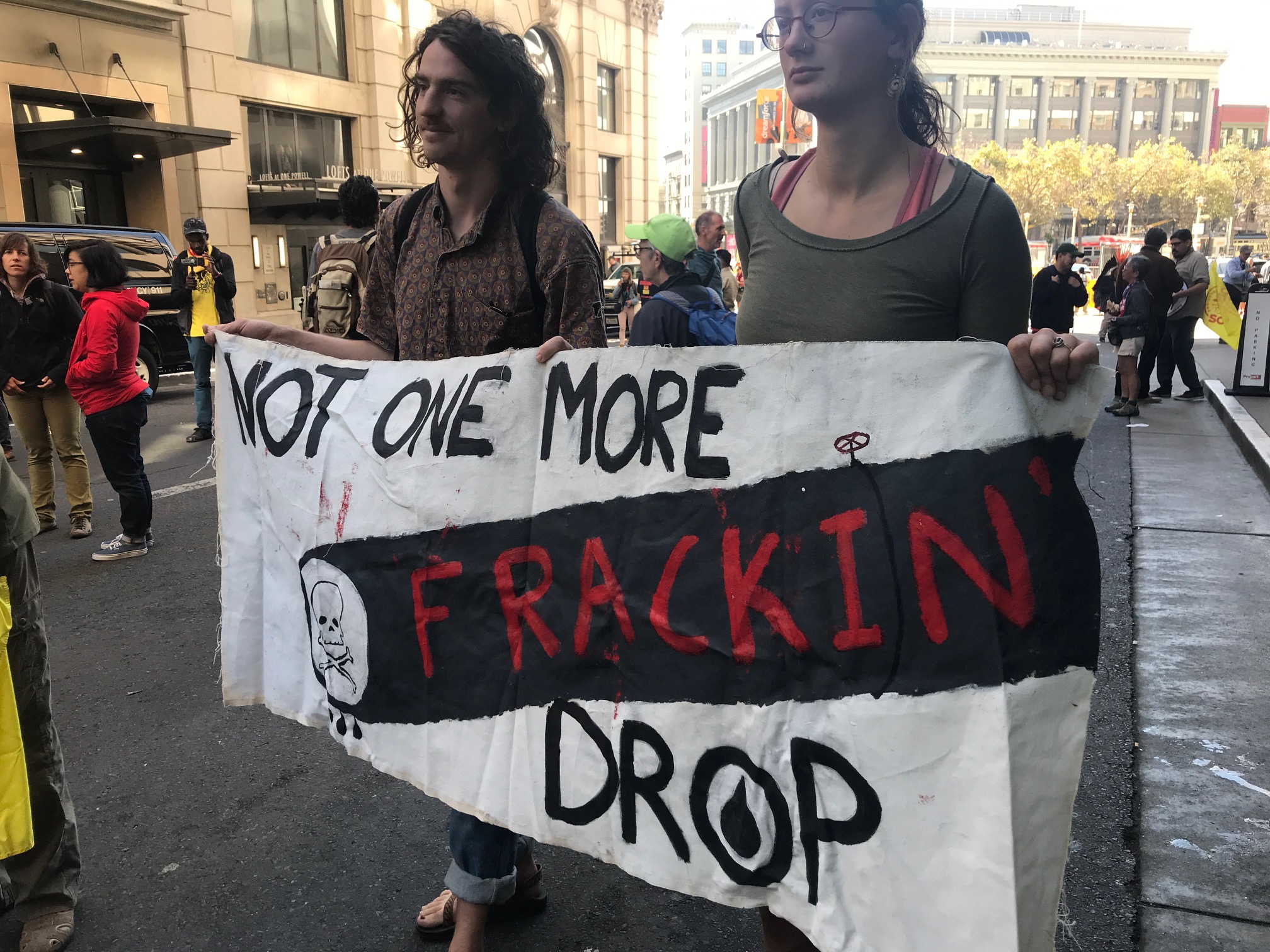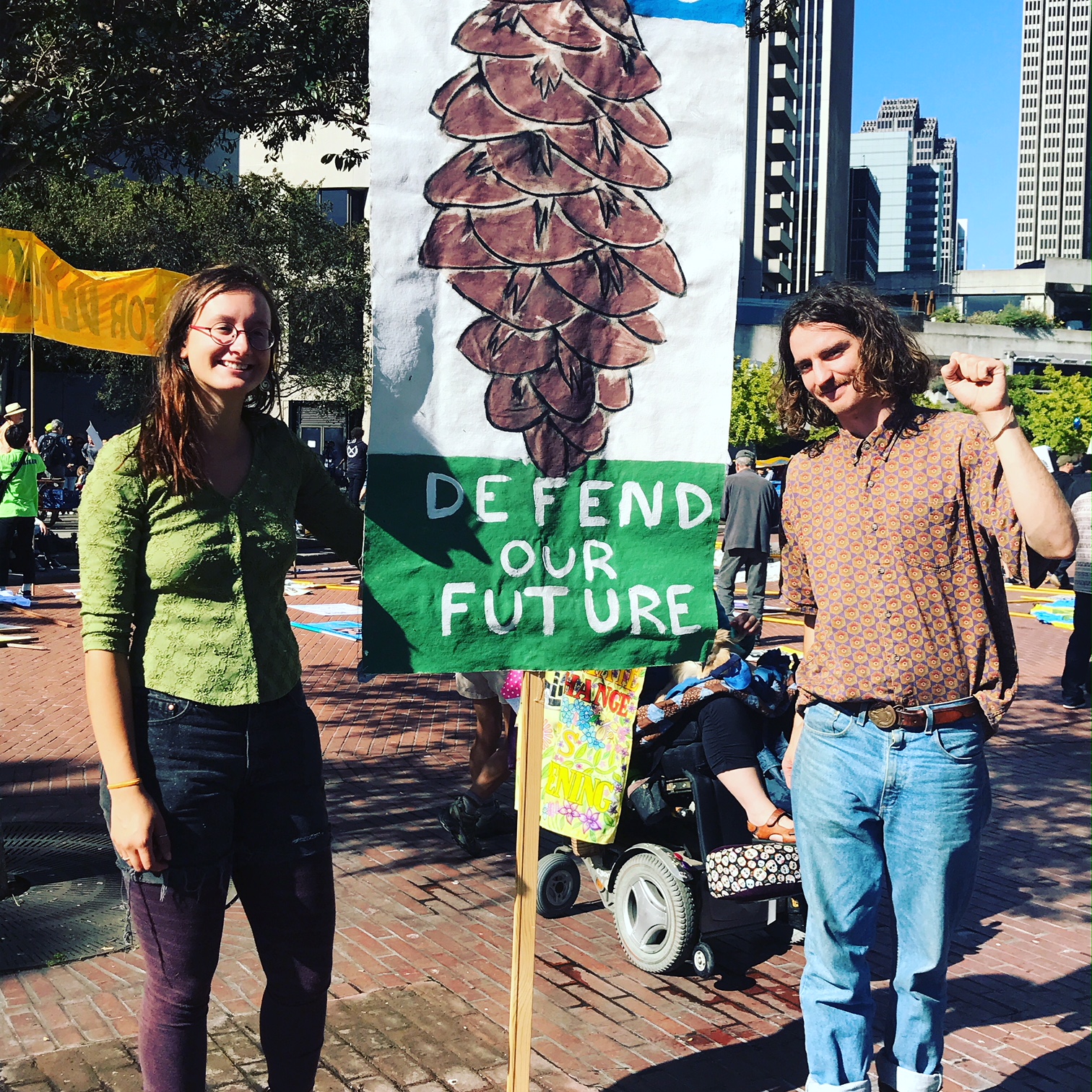
By Dylan Plummer, Madeline Cowen, and Sam Krop
Chants of ‘keep it in the ground’ floated on the early morning breeze in downtown San Francisco as we joined tens of thousands of demonstrators gathering for the People’s Climate March. A sea of colorful banners waved against the morning light, reading things ranging from ‘Quaker’s against climate change’ to ‘water is life’ in the Ojibwe language mni wichoni The energy was intoxicating as children, elderly, students, tribal members, and activists of all stripes partook in the march, slowly and deliberately moving towards the distant city hall, where hundreds of organizations would converge in shared art, music and a common goal to stop the destruction wrought by the fossil fuel industry.
On September 8th, hundreds of thousands of demonstrators marched across the world for climate action. The action that Cascadia Wildlands members joined in San Francisco was part of the Rise for Climate, Jobs and Justice march, the largest march in the US, organized as a response to California Governor Jerry Brown’s global climate action summit this week. At the summit, Brown is promoting his “real climate leadership” credentials on a global stage, while hypocritically refusing to commit to cancel new fossil fuel infrastructure or to ensure the future stability of frontline communities suffering from fossil fuel projects. Saturday’s march aimed to highlight the inconsistencies between Brown’s words and his practice, and to encourage him to use his last term as governor to make meaningful changes to California’s climate policy. Calling itself #brownslastchance, a central demand of the protest was to put a halt to all new future fossil fuel infrastructure in the state. The march on Saturday was the first event kicking off a week of indigenous-led climate action in the bay area and around the globe.

The Cascadia contingent joined the uprising in the bay to tie Oregonians’ struggle against fracked gas infrastructure to the larger global resistance to fossil fuels and climate change. Specifically, our goal was to encourage Oregon’s Governor (Kate) Brownto take a firm stance against the largest proposed climate polluter in the state, the Jordan Cove LNG Export facility and Pacific Connector Pipeline.

The Jordan Cove project would consist of a 229 mile long pipeline through southern Oregon crossing over 400 waterbodies, including five major salmon bearing rivers and the drinking water supplies for several communities. The confederated Klamath tribes are in opposition to the project as it would cross sacred burial sites, threaten treaty fishing rights, and contribute to climate change that would further degrade their traditional lands. Many potentially impacted landowners, including ranchers and rural communities, are also against the project, citing concerns for safety, property values, and the ecological integrity of the region.
As Governor Kate Brown couldn’t make it to the important climate summit, we figured we’d bring Oregon’s resident ‘climate leader’ there in spirit. So, we drove the now infamous giant paper-mache replica of Governor Kate Brown’s head over 500 miles down to join the rally in San Francisco and show her commitment to a stable climate and sustainable future.

At the rally, Gov. Brown 2.0 marched with her constituents, got ‘climate woke’ with Rise organizers and made binding commitments against the Jordan Cove pipeline and all future fossil fuel infrastructure.

While Governor Brown 2.0 was willing to walk her talk on climate leadership this weekend, the real Governor Brown has declined to attend this pivotal climate conference and continues to stay silent on the Jordan Cove project, leading some to question the authenticity of her posturing on environmental issues.

There is extensive evidence that a combination of climate change and irresponsible forestry practices are at the root of the past decade’s increasingly extreme fire seasons, and it was fitting that our drive down to the Bay took longer than expected because the ongoing Delta Fire had closed a large section of Interstate 5. Just south of Shasta, we were require to take a long and winding detour through heavy smoke, which we could feel the thick presence of, even though we were driving in the night.
Thankfully, when we returned home to Eugene, the Delta fire was contained enough for I5 to once again be opened, allowing us to drive straight through the burned forests between Shasta and Redding. As we witnessed the forest settling into recovery from the fire, we couldn’t help but reflect on the emergent need for climate action and sane, science-backed environmental policy. We Cascadians are already feeling the effects of climate change, and it’s high time we acted collectively to ensure a climate safe future. Yes, it is #brownslastchance, but it is also the last for all of us to make meaningful change.

Cascadia Wildlands is at the forefront of the fight for responsible forest management in our bioregion to ensure clean air and a healthy climate for future generations. We are also part of a mighty, state-wide coalition demanding that Governor Kate Brown take climate action seriously and halt the single most destructive climate proposal in our state. We are part of a larger growing movement for climate justice across the country and the world, and we won’t give in until we see our goal for a halt to the construction of all new fossil fuel infrastructure met. To get involved in Cascadia’s WildCAT team and plug in to our fossil fuel resistance world, email sam@old.cascwild.org.



